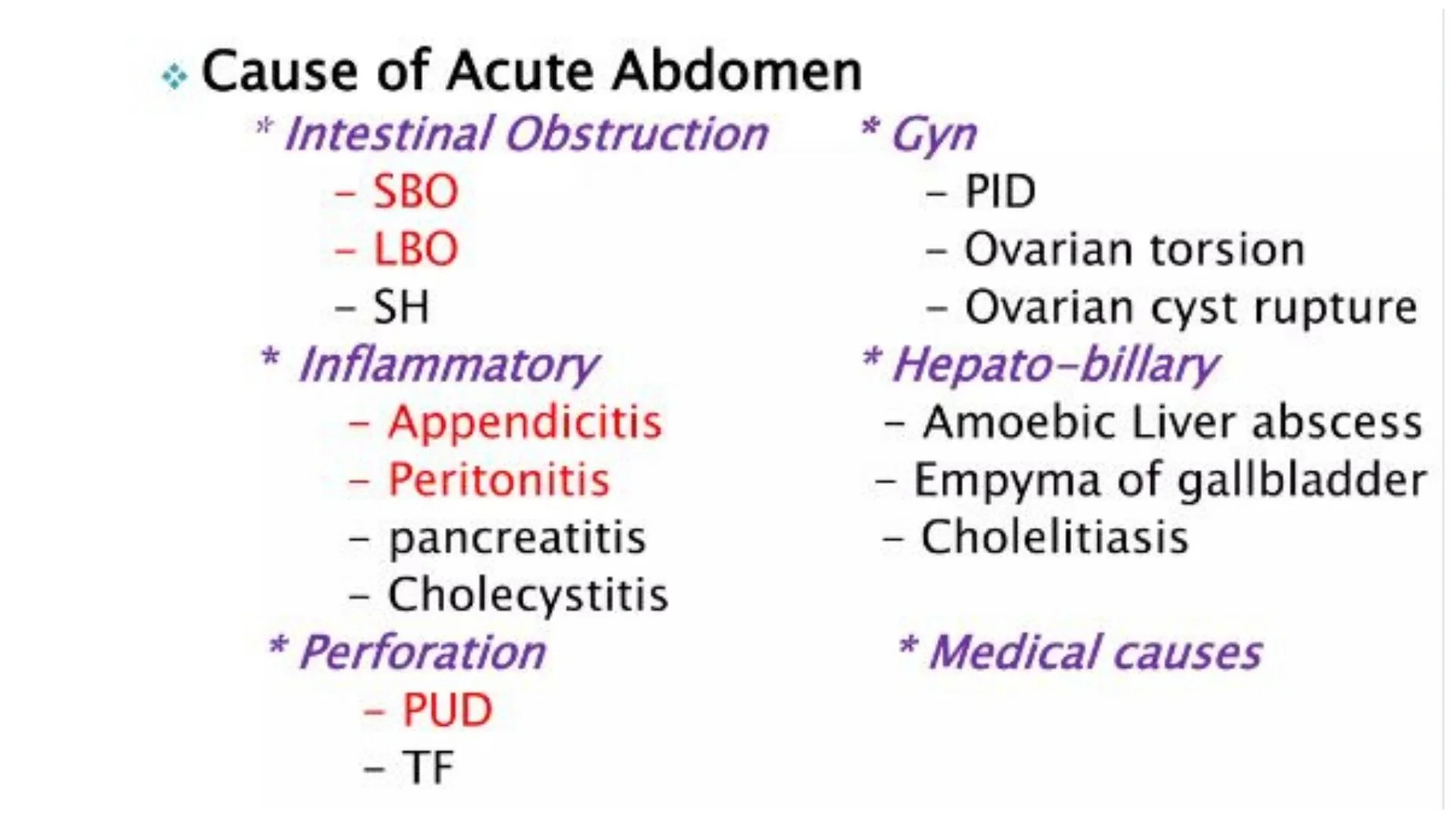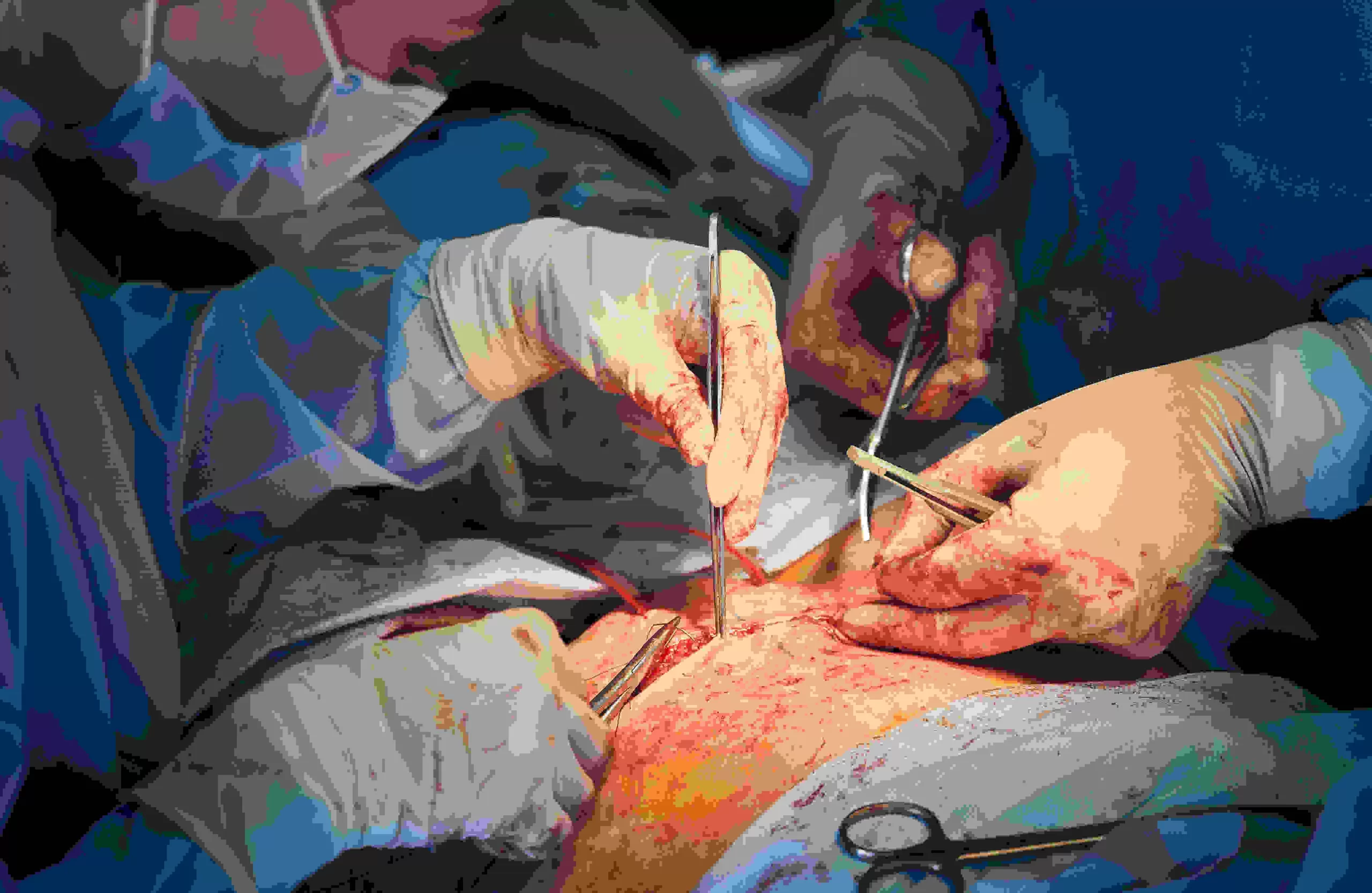The term “acute abdomen” refers to the sudden onset of severe abdominal pain that typically requires urgent medical attention. This condition is not a diagnosis itself but rather a symptom of an underlying issue that could range from benign to life-threatening. Understanding the causes, symptoms, and management of acute abdomen is crucial for timely and effective treatment.
What Is Acute Abdomen?
Acute abdomen is a clinical term used to describe a condition characterized by severe, often sudden, abdominal pain. The pain may be localized or diffuse, and it often signals a serious underlying problem that requires prompt diagnosis and intervention. The cause of acute abdomen can be varied, including conditions affecting the gastrointestinal tract, reproductive organs, urinary system, or even the cardiovascular system.
Causes of Acute Abdomen
The causes of acute abdomen are numerous and can be broadly categorized based on the affected organ systems:
1. Gastrointestinal Causes
- Appendicitis: Inflammation of the appendix, leading to severe pain, typically in the lower right abdomen.
- Cholecystitis: Inflammation of the gallbladder, often due to gallstones, causing pain in the upper right abdomen.
- Pancreatitis: Inflammation of the pancreas, causing severe upper abdominal pain that may radiate to the back.
- Peptic Ulcer Perforation: A hole in the stomach or duodenum wall, leading to sudden, severe pain and potential peritonitis.
- Bowel Obstruction: Blockage in the intestines, causing cramping pain, vomiting, and distension.
- Diverticulitis: Inflammation or infection of diverticula in the colon, leading to pain, usually in the lower left abdomen.
2. Gynecological Causes
- Ectopic Pregnancy: A pregnancy that occurs outside the uterus, often in a fallopian tube, causing severe pain and potentially life-threatening complications.
- Ovarian Torsion: Twisting of an ovary, cutting off its blood supply and causing severe, sudden pain.
- Pelvic Inflammatory Disease (PID): Infection of the female reproductive organs, leading to lower abdominal pain.
3. Urological Causes
- Kidney Stones: Small, hard deposits that form in the kidneys and can cause excruciating pain as they pass through the urinary tract.
- Acute Pyelonephritis: Infection of the kidneys, causing flank pain, fever, and urinary symptoms.
4. Vascular Causes
- Abdominal Aortic Aneurysm (AAA) Rupture: A life-threatening condition where the large blood vessel that supplies blood to the abdomen, pelvis, and legs ruptures, causing severe back or abdominal pain.
- Mesenteric Ischemia: Reduced blood flow to the intestines, leading to severe abdominal pain and potential bowel necrosis.

Symptoms Of Acute Abdomen
The symptoms of acute abdomen can vary widely depending on the underlying cause, but the hallmark symptom is severe abdominal pain. Here are the common symptoms associated with acute abdomen:
1. Severe Abdominal Pain
- Sudden Onset: The pain usually comes on suddenly and can be intense.
- Location: The pain may be localized (e.g., lower right abdomen in appendicitis) or diffuse (spread across the entire abdomen).
- Character: The pain can be sharp, stabbing, crampy, or dull, depending on the cause.
2. Nausea and Vomiting
- Often accompany abdominal pain, especially in cases of bowel obstruction, pancreatitis, or gallbladder issues.
3. Bloating and Abdominal Distension
- The abdomen may appear swollen, particularly in cases of bowel obstruction or fluid accumulation.
4. Tenderness
- The abdomen may be tender to touch, with some areas more sensitive than others.
- Rebound Tenderness: Pain that worsens when pressure on the abdomen is quickly released, indicating peritoneal irritation.
5. Changes in Bowel Movements
- Constipation: Common in bowel obstruction or severe infections.
- Diarrhea: Can occur in infections or inflammatory conditions like diverticulitis.
6. Fever
- Often indicates infection or inflammation, such as in appendicitis or cholecystitis.
7. Shock Symptoms
- Low Blood Pressure: Can occur in severe cases like a ruptured abdominal aortic aneurysm.
- Rapid Heart Rate: Often accompanies low blood pressure and shock.
- Cold, Clammy Skin: A sign of severe distress and shock.
8. Referred Pain
- Pain that originates in the abdomen but is felt in other areas, such as the shoulder (due to diaphragmatic irritation) or back (as in pancreatitis).
9. Difficulty Breathing
- The pain may be so severe that it affects breathing, especially in cases like diaphragmatic irritation or peritonitis.
10. Guarding
- Involuntary tensing of the abdominal muscles when the area is touched, a sign of peritonitis.
These symptoms require prompt medical evaluation to identify the cause and begin appropriate treatment.
Diagnosis Of Acute Abdomen
Diagnosing acute abdomen involves a systematic approach that includes taking a detailed medical history, performing a physical examination, and conducting various diagnostic tests. The goal is to quickly identify the underlying cause of the abdominal pain so that appropriate treatment can be initiated.
1. Medical History
- Onset and Nature of Pain: Details about when the pain started, its location, intensity, and whether it has moved or changed in character.
- Associated Symptoms: Presence of nausea, vomiting, fever, changes in bowel movements, or urinary symptoms.
- Past Medical History: Previous abdominal surgeries, chronic illnesses (e.g., peptic ulcer disease, gallstones), or recent trauma.
- Medications: Current medications, including over-the-counter drugs, which might contribute to symptoms.
- Lifestyle Factors: Diet, alcohol consumption, and smoking, which can influence abdominal conditions.
2. Physical Examination
- Inspection: Visual examination of the abdomen for distension, visible masses, or scars from previous surgeries.
- Palpation: Gentle pressing on the abdomen to identify areas of tenderness, guarding (involuntary muscle tightening), or rebound tenderness (pain upon release of pressure).
- Percussion: Tapping on the abdomen to detect fluid (ascites), air (as in bowel obstruction), or masses.
- Auscultation: Listening with a stethoscope for bowel sounds, which can indicate obstruction (high-pitched sounds) or peritonitis (absent sounds).
3. Laboratory Tests
- Complete Blood Count (CBC): To detect signs of infection or inflammation, such as elevated white blood cell count.
- Electrolytes and Renal Function Tests: To assess overall metabolic status and identify dehydration or electrolyte imbalances.
- Liver Function Tests (LFTs): To evaluate for liver disease or bile duct obstruction.
- Amylase and Lipase: Elevated levels can indicate pancreatitis.
- Urinalysis: To check for urinary tract infections, kidney stones, or hematuria (blood in urine).
- Pregnancy Test: For women of childbearing age, to rule out ectopic pregnancy.
4. Imaging Studies
- Ultrasound: Often the first imaging test performed, especially for gallbladder disease, kidney stones, or gynecological issues.
- X-rays: Abdominal X-rays can detect bowel obstruction, free air under the diaphragm (suggesting perforation), or calcifications (such as kidney stones).
- CT Scan: A more detailed imaging study that can help diagnose conditions like appendicitis, diverticulitis, pancreatitis, or abdominal trauma. It is often the preferred method for evaluating acute abdomen.
- MRI: Used in certain cases where more detailed imaging is required, particularly for soft tissue evaluation.
- Barium Studies: Sometimes used to evaluate bowel obstruction or perforations, although less common with the availability of advanced imaging techniques.
5. Specialized Tests
- Endoscopy: An internal examination using a camera on a flexible tube, used for diagnosing conditions like peptic ulcers, gastritis, or esophageal perforations.
- Laparoscopy: A minimally invasive surgical procedure that allows direct visualization of the abdominal cavity, often used when imaging and other tests are inconclusive.
6. Electrocardiogram (ECG)
- ECG: To rule out cardiac causes of abdominal pain, particularly in older adults or those with risk factors for heart disease, as heart attacks can sometimes present as abdominal pain.
7. Exploratory Surgery
- Laparotomy: In cases of suspected surgical acute abdomen where the diagnosis remains unclear and the patient’s condition is worsening, an exploratory surgery may be performed to identify and treat the underlying cause.
Treatment Of Acute Abdomen
Management of acute abdomen depend on the underlying cause and the severity of the condition. Given the potential for life-threatening complications, prompt and appropriate intervention is crucial. Here’s an overview of the management and treatment strategies for acute abdomen:
1. Initial Assessment and Stabilization
- Vital Signs Monitoring: Regularly check blood pressure, heart rate, respiratory rate, and temperature to assess the patient’s overall condition.
- Oxygen Therapy: Administer oxygen if the patient is showing signs of respiratory distress or shock.
- NPO (Nil Per Os): Keep the patient NPO (nothing by mouth) to prepare for potential surgery or further diagnostic procedures.
2. Medical Management
Pain Management
- Analgesics: Pain relief is a priority. Opioids (e.g., morphine) are commonly used, but care is taken to avoid masking symptoms that are important for diagnosis. Non-opioid analgesics may also be considered depending on the situation.
Fluid and Electrolyte Management
- Intravenous Fluids: IV fluids are administered to correct dehydration, maintain blood pressure, and stabilize the patient, especially in cases of shock or significant fluid loss due to vomiting, diarrhea, or bleeding.
- Electrolyte Correction: Electrolyte imbalances (e.g., potassium, sodium) are corrected based on laboratory results, as imbalances can complicate the patient’s condition.
Antibiotic Therapy
- Broad-Spectrum Antibiotics: Antibiotics are often given prophylactically or to treat infections such as peritonitis, appendicitis, or diverticulitis. The choice of antibiotics depends on the suspected or confirmed pathogen, the location of the infection, and the patient’s overall health.
- Tailored Therapy: If cultures identify a specific pathogen, antibiotic therapy may be adjusted accordingly to target the bacteria more effectively.
Gastrointestinal Decompression
- Nasogastric Tube (NG Tube): An NG tube may be inserted to relieve vomiting, reduce abdominal distension, and decompress the stomach in cases of bowel obstruction or severe gastroenteritis. This helps prevent aspiration and provides symptomatic relief.
Acid Suppression Therapy
- Proton Pump Inhibitors (PPIs): Medications like omeprazole or pantoprazole are used to reduce stomach acid production, particularly in cases where peptic ulcer disease or gastritis is suspected.
- H2-Receptor Antagonists: Drugs like ranitidine or famotidine may also be used to decrease acid production, especially when there is a need to manage GERD symptoms or mild ulcer disease.
Antiemetic Therapy
- Antiemetics: Medications such as ondansetron or metoclopramide are used to control nausea and vomiting, which are common in acute abdomen. Controlling these symptoms can improve patient comfort and prevent complications such as dehydration.
Bowel Management
- Laxatives or Enemas: If the patient has constipation or is suspected of having a partial bowel obstruction, laxatives or enemas might be cautiously used, although they are typically avoided in cases where obstruction or perforation is likely.
- Bowel Rest: Patients may be kept NPO (nothing by mouth) to rest the gastrointestinal tract, particularly in conditions like pancreatitis, bowel obstruction, or peritonitis.
Specific Medical Treatments
- Anti-inflammatory Medications: For conditions like pancreatitis or inflammatory bowel disease (IBD), corticosteroids or other anti-inflammatory drugs may be indicated to reduce inflammation.
- Blood Transfusion: If the patient is experiencing significant bleeding, as might occur with a perforated ulcer or ruptured ectopic pregnancy, a blood transfusion may be necessary.
- Thrombolytics or Anticoagulants: In cases of mesenteric ischemia or thrombosis, thrombolytic therapy (to dissolve clots) or anticoagulants (to prevent further clotting) may be administered.
Nutritional Support
- Total Parenteral Nutrition (TPN): In cases where oral intake is not possible for an extended period, TPN may be necessary to provide nutrition intravenously.
- Enteral Nutrition: If possible, enteral feeding through a tube may be considered once the acute phase has stabilized and the patient can tolerate some form of nutritional intake.
Monitoring and Supportive Care
- Continuous Monitoring: Regular monitoring of vital signs, urine output, and laboratory parameters (e.g., electrolytes, renal function) is essential to track the patient’s progress and detect any deterioration.
- Respiratory Support: Oxygen or ventilatory support may be required if the patient is in respiratory distress or has an associated condition such as aspiration pneumonia.
3. Surgical Intervention
Surgery is often required for acute abdomen, particularly when the condition is life-threatening or unresponsive to medical management. The type of surgery depends on the diagnosis:
- Appendectomy: Surgical removal of the appendix in cases of appendicitis.
- Cholecystectomy: Removal of the gallbladder for cholecystitis, particularly if gallstones are involved.
- Laparotomy: An open surgical procedure to explore the abdominal cavity when the diagnosis is unclear or when multiple potential causes need to be addressed simultaneously.
- Laparoscopy: A minimally invasive surgery that can be used both for diagnosis and treatment, such as removing an inflamed appendix, repairing perforations, or treating ectopic pregnancies.
- Bowel Resection: Removing a diseased portion of the intestine in cases of bowel obstruction, ischemia, or perforation.
- Repair of Abdominal Aortic Aneurysm (AAA): Emergency surgery is required if an AAA ruptures, involving either open surgery or an endovascular approach.

4. Postoperative Care
- Monitoring: Post-surgical patients require close monitoring for complications like infections, bleeding, or organ dysfunction.
- Pain Management: Continue to manage pain postoperatively, typically with opioids or other pain relief methods.
- Antibiotics: Continue antibiotic therapy if an infection was involved.
- Nutritional Support: Gradually reintroduce oral intake as tolerated, starting with clear liquids and advancing to a regular diet. In some cases, nutritional support via IV may be necessary.
- Mobility: Encourage early mobilization to prevent complications such as deep vein thrombosis (DVT) and promote recovery.
5. Long-Term Management and Follow-Up
- Lifestyle Modifications: Depending on the underlying cause, patients may need to make dietary changes, avoid certain activities, or take long-term medications to prevent recurrence (e.g., in peptic ulcer disease or gallstones).
- Regular Follow-Up: Patients may require follow-up imaging, blood tests, or other assessments to monitor recovery and prevent complications.
- Patient Education: Educate patients about the signs and symptoms of recurrence and when to seek immediate medical attention.
6. Special Considerations
- Elderly Patients: The elderly may present with atypical symptoms and are at higher risk for complications, requiring careful monitoring and sometimes more aggressive treatment.
- Pregnant Women: Management must be adapted to minimize risks to both the mother and fetus, with careful consideration of the timing and type of surgical intervention.
Conclusion
Acute abdomen is a medical emergency that requires prompt attention and often immediate treatment. The wide range of potential causes makes it a challenging condition to diagnose, but with rapid and accurate assessment, most underlying issues can be effectively managed. Recognizing the signs and seeking timely medical care are critical for improving outcomes and preventing complications. If you or someone you know experiences sudden, severe abdominal pain, do not hesitate to seek emergency medical attention.
Disclaimer: This information provides a general overview of diagnosis, treatment, and medication related to alopecia areata. It is intended to assist in understanding potential options but is not comprehensive. This content is not a substitute for professional medical advice, diagnosis, or treatment. It does not cover all possible conditions, treatments, side effects, or risks specific to individual cases. For personalized medical advice, please consult a healthcare provider who can evaluate your unique circumstances. This information does not endorse or validate any specific treatments or medications.



